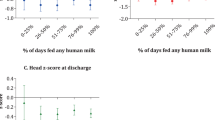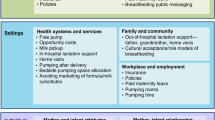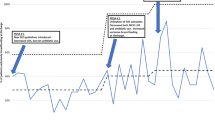Abstract
Objective:
To study the incidence of sepsis and neonatal intensive care unit (NICU) costs as a function of the human milk (HM) dose received during the first 28 days post birth for very low birth weight (VLBW) infants.
Study design:
Prospective cohort study of 175 VLBW infants. The average daily dose of HM (ADDHM) was calculated from daily nutritional data for the first 28 days post birth (ADDHM-Days 1–28). Other covariates associated with sepsis were used to create a propensity score, combining multiple risk factors into a single metric.
Result:
The mean gestational age and birth weight were 28.1±2.4 weeks and 1087±252 g, respectively. The mean ADDHM-Days 1–28 was 54±39 ml kg−1 day−1 (range 0–135). Binary logistic regression analysis controlling for propensity score revealed that increasing ADDHM-Days 1–28 was associated with lower odds of sepsis (odds ratio 0.981, 95% confidence interval 0.967–0.995, P=0.008). Increasing ADDHM-Days 1–28 was associated with significantly lower NICU costs.
Conclusion:
A dose–response relationship was demonstrated between ADDHM-Days 1–28 and a reduction in the odds of sepsis and associated NICU costs after controlling for propensity score. For every HM dose increase of 10 ml kg−1 day−1, the odds of sepsis decreased by 19%. NICU costs were lowest in the VLBW infants who received the highest ADDHM-Days 1–28.
This is a preview of subscription content, access via your institution
Access options
Subscribe to this journal
Receive 12 print issues and online access
$259.00 per year
only $21.58 per issue
Buy this article
- Purchase on Springer Link
- Instant access to full article PDF
Prices may be subject to local taxes which are calculated during checkout



Similar content being viewed by others
References
Fanaroff AA, Stoll BJ, Wright LL, Carlo WA, Ehrenkranz RA, Stark AR et al. Trends in neonatal morbidity and mortality for very low birthweight infants. Am J Obstet Gynecol 2007; 196 (147): e1–147 e8.
Johnson TJ, Patel AL, Jegier B, Engstrom JL, Meier J . The cost of morbidities in very low birth weight infant. J Pediatr 2013; 162: 243–249.e1.
Stoll BJ, Hansen NI, Adams-Chapman I, Fanaroff AA, Hintz SR, Vohr B et al. Neurodevelopmental and growth impairment among extremely low-birth-weight infants with neonatal infection. JAMA 2004; 292: 2357–2365.
Payne NR, Carpenter JH, Badger GJ, Horbar JD, Rogowski J . Marginal increase in cost and excess length of stay associated with nosocomial bloodstream infections in surviving very low birth weight infants. Pediatrics 2004; 114: 348–355.
Stevenson RC, Pharoah POD, Stevenson CJ, McCabe CJ, Cooke RWI . Cost of care for a geographically determined population of low birthweight infants to age 8–9 years. II. children with disability. Arch Dis Child 1996; 74: F118–F121.
Schanler RJ, Shulman RJ, Lau C . Feeding strategies for premature infants: beneficial outcomes of feeding fortified human milk versus preterm formula. Pediatrics 1999; 103: 1150–1157.
Furman L, Taylor G, Minich N, Hack M . The effect of maternal milk on neonatal morbidity of very low-birth-weight infants. Arch Pediatr Adolesc Med 2003; 157: 66–71.
Hylander MA, Strobino DM, Dhanireddy R . Human milk feedings and infection among very low birth weight infants. Pediatrics 1998; 102: E38.
Patel AL, Meier PP, Engstrom JL . The evidence for use of human milk in very low-birthweight preterm infants. NeoReviews 2007; 8: e459–e466.
Sisk PM, Lovelady CA, Dillard RG, Gruber KJ, O’Shea TM . Early human milk feeding is associated with a lower risk of necrotizing enterocolitis in very low birth weight infants. J Perinatol 2007; 27: 428–433.
Meier PP, Engstrom JL, Patel AL, Jegier BJ, Bruns N . Improving the use of human milk during and after the NICU stay. Clin Perinatol 2010; 37: 217–245.
Meier PP . Health benefits and cost of human milk for very low birthweight infants 2007; 1, R01-NR010009-01.
Phibbs CS, Schmitt SK . Estimates of the cost and length of stay changes that can be attributed to one-week increases in gestational age for premature infants. Early Hum Dev 2006; 82: 85–95.
St John EB, Nelson KG, Cliver SP, Bishnoi RR, Goldenberg RL . Cost of neonatal care according to gestational age at birth and survival status. Obstet Gynecol 2000; 182 (1 Pt 1): 170–175.
Rodriguez NA, Meier PP, Groer MW, Zeller JM, Engstrom JL, Fogg L . A pilot study of the oropharyngeal administration of own mother’s colostrum to extremely low birth weight infants. Adv Neonatal Care 2010; 10: 206–212.
Sullivan S, Schanler RJ, Kim JH, Patel AL, Trawoger R, Kiechl-Kohlendorfer U et al. An exclusively human milk-based diet is associated with a lower rate of necrotizing enterocolitis than a diet of human milk and bovine milk-based products. J Pediatr 2010; 156: 562–567.
Meier PP, Engstrom JL, Murtaugh MA, Vasan U, Meier WA, Schanler RJ . Mothers’ milk feedings in the neonatal intensive care unit: accuracy of the creamatocrit technique. J Perinatol 2002; 22 (8): 646–649.
Bureau of Labor Statistics. Consumer price index for all items, 2008–2010. Updated 2012. http://www.bls.gov/data/. Retrieval date 19 February 2012.
Rosenbaum PR, Rubin DB . The central role of the propensity score in observational studies for causal effects. Biometrika 1983; 70: 41–55.
Stoll BJ, Hansen N, Fanaroff AA, Wright LL, Carlo WA, Ehrenkranz RA et al. Late-onset sepsis in very low birth weight neonates: the experience of the NICHD neonatal research network. Pediatrics 2002; 110: 285–291.
Perlman SE, Saiman L, Larson EL . Risk factors for late-onset health care-associated bloodstream infections in patients in neonatal intensive care units. Am J Infect Control 2007; 35: 177–182.
Manning WG, Mullahy J . Estimating log models: to transform or not to transform? J Health Econ 2001; 20: 461–494.
Newburg DS, Walker WA . Protection of the neonate by the innate immune system of developing gut and of human milk. Pediatr Res 2007; 61: 2–8.
Lonnerdal B . Nutritional and physiologic significance of human milk proteins. Am J Clin Nutr 2003; 77: 1537S–1543S.
Hirai C, Ichiba H, Saito M, Shintaku H, Yamano T, Kusuda S . Trophic effect of multiple growth factors in amniotic fluid or human milk on cultured human fetal small intestinal cells. J Pediatr Gastroenterol Nutr 2002; 34: 524–528.
Bjornvad CR, Thymann T, Deutz NE, Burrin DG, Jensen SK, Jensen BB et al. Enteral feeding induces diet-dependent mucosal dysfunction, bacterial proliferation, and necrotizing enterocolitis in preterm pigs on parenteral nutrition. Am J Physiol Gastrointest Liver Physiol 2008; 295: G1092–G1103.
Taylor SN, Basile LA, Ebeling M, Wagner CL . Intestinal permeability in preterm infants by feeding type: mother's milk versus formula. Breastfeed Med 2009; 4: 11–15.
Sangild PT . Gut responses to enteral nutrition in preterm infants and animals. Exp Biol Med 2006; 231: 1695–1711.
Stoll B, Hansen N, Bell EF, Shankaran S, Laptook A, Walsh M et al. Neonatal outcomes of extremely preterm infants from the NICHD neonatal research network. Pediatrics 2010; 126: 443–456.
Li R, Darling N, Maurice E, Barker L, Grummer-Strawn LM . Breastfeeding rates in the United States by characteristics of the child, mother, or family: the 2002 national immunization survey. Pediatrics 2005; 115: e31–e37.
Acknowledgements
We acknowledge statistical assistance from Michael E Schoeny, PhD and David B Henry, PhD. This study was funded by NIH Grant NR010009.
Author information
Authors and Affiliations
Corresponding author
Ethics declarations
Competing interests
The authors declare no conflict of interest.
Rights and permissions
About this article
Cite this article
Patel, A., Johnson, T., Engstrom, J. et al. Impact of early human milk on sepsis and health-care costs in very low birth weight infants. J Perinatol 33, 514–519 (2013). https://doi.org/10.1038/jp.2013.2
Received:
Revised:
Accepted:
Published:
Issue Date:
DOI: https://doi.org/10.1038/jp.2013.2
Keywords
This article is cited by
-
Early pumping frequency and coming to volume for mother’s own milk feeding in hospitalized infants
Journal of Perinatology (2023)
-
Multi-prong quality improvement approach for increasing mother’s own milk use for very low birth weight infants
Journal of Perinatology (2023)
-
Understanding the Domains of Experiences of Black Mothers with Preterm Infants in the United States: A Systematic Literature Review
Journal of Racial and Ethnic Health Disparities (2023)
-
Study protocol for reducing disparity in receipt of mother’s own milk in very low birth weight infants (ReDiMOM): a randomized trial to improve adherence to sustained maternal breast pump use
BMC Pediatrics (2022)
-
‘They said, let’s teach you how you are going to care for the child at home…’: caregivers’ and healthcare worker’s perceptions and experiences of post-discharge preterm care in eastern Uganda
BMC Health Services Research (2022)



